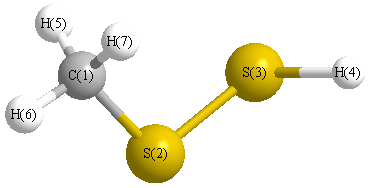Vibrational Frequencies calculated at SVWN/aug-cc-pVTZ
| Mode Number |
Symmetry |
Frequency
(cm-1) |
Scaled Frequency
(cm-1) |
IR Intensities
(km mol-1) |
Raman Act
(Å4/u) |
Dep P |
Dep U |
|---|
| 1 |
A |
3076 |
3052 |
1.16 |
63.84 |
0.75 |
0.86 |
| 2 |
A |
3063 |
3039 |
2.11 |
92.92 |
0.73 |
0.85 |
| 3 |
A |
2967 |
2944 |
9.77 |
240.61 |
0.03 |
0.06 |
| 4 |
A |
2536 |
2516 |
4.49 |
204.03 |
0.21 |
0.35 |
| 5 |
A |
1393 |
1382 |
11.35 |
4.58 |
0.73 |
0.84 |
| 6 |
A |
1370 |
1359 |
12.14 |
5.85 |
0.75 |
0.86 |
| 7 |
A |
1263 |
1253 |
0.83 |
1.09 |
0.75 |
0.86 |
| 8 |
A |
929 |
922 |
4.70 |
1.48 |
0.09 |
0.17 |
| 9 |
A |
924 |
916 |
4.22 |
0.98 |
0.10 |
0.18 |
| 10 |
A |
842 |
835 |
4.91 |
15.36 |
0.40 |
0.57 |
| 11 |
A |
708 |
703 |
3.95 |
8.32 |
0.21 |
0.34 |
| 12 |
A |
517 |
513 |
0.63 |
8.67 |
0.11 |
0.20 |
| 13 |
A |
327 |
325 |
12.50 |
0.98 |
0.75 |
0.86 |
| 14 |
A |
232 |
231 |
0.25 |
5.67 |
0.51 |
0.67 |
| 15 |
A |
160 |
158 |
0.47 |
0.01 |
0.74 |
0.85 |
Unscaled Zero Point Vibrational Energy (zpe) 10153.9 cm
-1
Scaled (by 0.9921) Zero Point Vibrational Energy (zpe) 10073.7 cm
-1
See section
III.C.1 List or set vibrational scaling factors
to change the scale factors used here.
See section
III.C.2
Calculate a vibrational scaling factor for a given set of molecules
to determine the least squares best scaling factor.
Charges, Dipole, Quadrupole and Polarizability
Charges from optimized geometry at SVWN/aug-cc-pVTZ
Charges (e)
| Number |
Element |
Mulliken |
CHELPG |
AIM |
ESP |
| 1 |
C |
-0.636 |
|
|
|
| 2 |
S |
0.009 |
|
|
|
| 3 |
S |
-0.213 |
|
|
|
| 4 |
H |
0.139 |
|
|
|
| 5 |
H |
0.263 |
|
|
|
| 6 |
H |
0.195 |
|
|
|
| 7 |
H |
0.243 |
|
|
|
Electric dipole moments
Electric dipole components in Debye
(What's a Debye? See section
VII.A.3)
| |
x |
y |
z |
Total |
| |
-1.070 |
1.177 |
0.760 |
1.763 |
| CHELPG |
|
|
|
|
| AIM |
|
|
|
|
| ESP |
|
|
|
|
Electric Quadrupole moment
Quadrupole components in D Å
| Primitive |
|---|
| | x | y | z |
|---|
| x |
-31.020 |
-0.251 |
1.548 |
| y |
-0.251 |
-35.165 |
0.579 |
| z |
1.548 |
0.579 |
-33.321 |
|
| Traceless |
|---|
| | x | y | z |
|---|
| x |
3.223 |
-0.251 |
1.548 |
| y |
-0.251 |
-2.994 |
0.579 |
| z |
1.548 |
0.579 |
-0.229 |
|
| Polar |
|---|
| 3z2-r2 | -0.458 |
|---|
| x2-y2 | 4.145 |
|---|
| xy | -0.251 |
|---|
| xz | 1.548 |
|---|
| yz | 0.579 |
|---|
|
Polarizabilities
Components of the polarizability tensor.
Units are
Å
3 (Angstrom cubed)
Change units.
| |
x |
y |
z |
| x |
11.227 |
0.159 |
0.208 |
| y |
0.159 |
8.248 |
0.073 |
| z |
0.208 |
0.073 |
7.270 |
<r2> (average value of r
2) Å
2
| <r2> |
101.073 |
| (<r2>)1/2 |
10.054 |
